Iridium Frequently Asked Questions
Can I use a Solar Charger to charge both my Iridium phone and my laptop computer at the same time?
|
|
Satellite Phone - How does it work?
How It WorksTopics (Click link to jump down) Overview of a Globalstar Phone Call

Making a Call via Satellite vs. Cellular
RoamingThe Globalstar system supports phones that are ANSI-41-based and GSM-based over the common Globalstar Air Interface (GAI). The GAI allows an ANSI-41 user to roam to an area served by GSM or vice versa. The Globalstar Gateway provides the ANSI-41 capability and works with a GSM Mobile Switching Center (MSC) for GSM capability. Each Gateway serving an area governed by GSM contains a GSM MSC.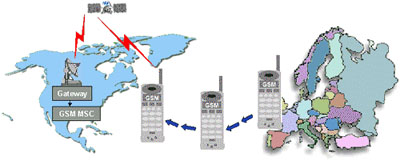
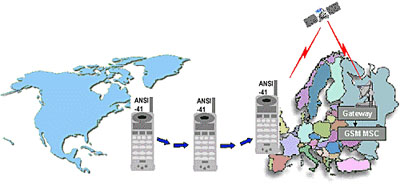 Similarly, if a subscriber with an ANSI-41 Tri-Mode phone roams to Europe, the phone will operate in Globalstar mode using ANSI-41 protocols.
Satellite ConstellationThe Globalstar constellation
consists of 48 LEO (low-Earth-orbiting) satellites, plus an
additional four satellites in orbit as spares. Each consists of an
antenna, a trapezoidal body, two solar arrays and a magnetometer,
and operates at an altitude of 1414km (876 miles). Globalstar System TechnologyGlobalstar System Works By
Merging Communications Technologies
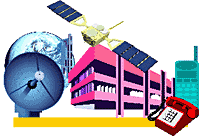 QUALCOMM's Role: How It Ties Together
QUALCOMM's Role: How It Ties TogetherGlobalstar's constellation transmits calls from your mobile or fixed satellite phone to a terrestrial Gateway developed by QUALCOMM and owned and operated by the Service Provider. These calls are passed through the Gateway and on to existing fixed and cellular telephone networks in more than 100 countries on 6 continents. Terrestrial Gateways are an important part of Globalstar's strategy to keep key technology and equipment easily accessible and to integrate services as closely as possible with existing local telephony networks. This makes the Globalstar Communications System and its services simple to manage. QUALCOMM, as designer and leader in the standardization and commercialization of CDMA technology for wireless applications, supplies Globalstar L.P. and Service Providers with:
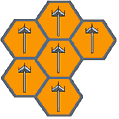 "Seamless" Phone Service Coverage Is Desired
"Seamless" Phone Service Coverage Is DesiredCellular mobile phone coverage is provided by a network of transceiver antennas clustered on transceiver towers. A network of circles is represented by hexagons. This shows the optimal placement of towers to eliminate "holes" in coverage (an area where mobile phone communication cannot be achieved). 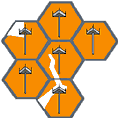 In the real world, coverage holes occur. Obstacles like hills, valleys, or man-made obstructions make the strength of signals between the phone and the cellular antennas inadequate. Mobile phone calls cannot be made or continued when the caller is in one of these holes. 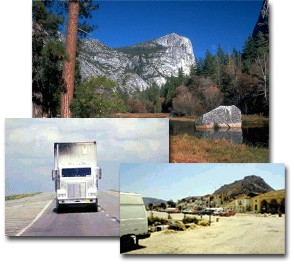 Globalstar Covers The World*
Globalstar Covers The World*Most of the world is NOT covered by cellular networks, whether in wilderness areas, on long-haul trucking routes, or in developing nations. A satellite phone system gives the consumer a single phone that can be used almost anywhere, whether next door or half-way around the world. * Except for polar regions or areas not currently covered by installed Gateways, including most of Greenland, small parts of Alaska, Canada, Scandinavia, Siberia, and regions in the Southern Hemisphere, including Antarctica and parts of South America.
Q & A - FAQ Q.
What is the type of the phone? Q.
In which countries has Thuraya signed roaming agreements with? Q.
What are Thuraya’s services? Q.
How many colours do Thuraya handsets come in? Q.
Does the Thuraya handset operate indoors? How can the user receive
calls? Thuraya's Fixed Docking Unit (FDU)- the Home/Office Docking product allows the usage of the Thuraya phone in an indoor environment such as home or office. The FDU will complement the Thuraya phone by extending its operations and functionalities inside buildings. Q.
Is Thuraya phone waterproof? Q.
How long should I charge the battery the first time? Q.
What are the terms of the warranty period? Q.
How much does Thuraya phone weigh? Q.
What is the Thuraya code? Q.
Where can I get more information about Thuraya’s products and
services? Q.
When did Thuraya’s services begin?
Q.
What are the monthly subscription fees? Q.
If someone tries to call me on my Thuraya phone while I'm
overseas—what will I be charged? Q.
If I’m a Thuraya subscriber, where will I pay my bill? Q.
If I am using a GSM card in my Thuraya phone, can I make satellite
calls? Which number would people reach me at? Q.
Are there any subscription charges for using my GSM SIM card on a
Thuraya phone? Q.
If there is no Service Provider in my country, how can I obtain
Thuraya services? Q.
How does Thuraya dual mode feature work? With your Thuraya
phone and GSM SIM, you will be automatically accessing your local
GSM operator’s network. Hence, your calls will be billed on your
normal GSM bill. You also have the option to roam into Thuraya’s
network to access satellite services given that Thuraya has already
established a roaming agreement with your local GSM operator. With a GSM phone
and a Thuraya SIM, you will be roaming from Thuraya into your local
GSM operator network given that Thuraya has already established a
roaming agreement with your local GSM operator. Nevertheless, it
will be impossible to access Thuraya services through your GSM phone
because Thuraya phones have special equipment that makes
communication with the satellite possible. Roaming
Q. Can you define Roaming in relation to Thuraya?A. Roaming is a facility that makes:
Q.
What are Thuraya’s roaming charges? Solutions
and Accessories
Q.
Does Thuraya have Prepaid scratch cards? Q.
Can I receive or make a call on a Thuraya phone while driving? Q.
Does Thuraya have a car kit? Thuraya's
Vehicular Docking Adaptor (VDA) is also available. Q.
What sort of accessories can I find for Thuraya phones? FDU Vehicular Docking Adaptor (VDA) Software Package Standard Battery Pack How do I use
Data and Fax services from a Thuraya phone? Global
Positioning System (GPS) and Short Messaging System (SMS) Q.How
can I give my location to someone? Q.Can
I use Thuraya’s GPS feature if the Thuraya phone is in GSM mode
(even when using an existing GSM SIM card)? Q. What is the
Thuraya SMS center number? A: Please follow
the procedure below:
Since Thuraya
considered a virtual country, always use full country codes and
numbers when sending SMS messages. Q.
In what languages does Thuraya phone support SMS? Technology Q. Why
is there a requirement for a large L-band antenna? Q. What is the excess
power that the satellite transmits during shadowing? Q. What is the handset
power in the satellite mode? Q. Why is the Thuraya
terminal antenna thickness larger than the normal GSM handset
antenna? Q. What are the main
differences between the Primary Gateway and the national gateways? The Satellite Operation Center (SOC) which operates and maintains the satellite The Advanced Operation Center (AOC), which is responsible for the radio resource management of the satellite traffic channels. The Central Operation Support System (OSS) which provides the functions for customer care, billing and SIM card personalization for the entire network (including the NGWs) The National Gateway contains a
gateway station but not the SOC, AOC, and OSS. However, a local
Operation and maintenance Center could be provided. Q. What is the effect of
the radiation of the Mobile Terminal to the human body? Q. What is the modulation
type? Q. What is Thuraya’s
blocking rate? Q. What security features
are built into the Thuraya links? Q. What is the size of the
Thuraya spacecraft L-band antenna?
Satellite
phone is a subscription radio service. It's
similar to cable television, in that it provides a wide range of
programming not available on traditional AM/FM radio for a monthly
fee. A
Satellite Phones vs. Cellular PhonesThe way cellular phones work they use zones or small base stations called “cells”. As you move from one area or “cell” your call is “handed off” from the old to the new cell. The switch to the new cell is accomplished by the sending of a special signal to the mobile unit. The Mobile Telephone Switching Office or MTSO connects the cellular calls with the Public Switched Telephone Network or (PSTN). The MTSO also controls all the cell sites. All the cell phones are registered with the control channel so the system knows where to find the cellular phone. Imagine in a perfect world the cells or zones looked like a large honey bee cone that covered the planet. But this is not possible. It is not cost effective for the cellular providers to put up cell towers in rural areas or many third world countries where there would be low usage. So this makes vast areas of the U.S. and other countries where a cellular phone does not have coverage because if you are not close to a cell tower your cell phone will not work. There is also the issue where your friend's cell phone may work in an area or “cell” and yours does not. That is because their phone is most likely using another cellular provider the uses a tower with a difference technology other than the technology compatible with your phone. Also it would be impossible to place towers out in the ocean far from land, again making your celullarl phone worthless when not close to a cell tower. Satellite Phones do not use “cells” or cell towers. The most popular hand held satellite telephones use Low Earth Orbiting or LEO satellites. When you turn on your satellite phone the signal goes up to any number of satellites in a compatible constellation where it is then registered with the constellation. Globalstar has 48 satellites and Iridium has 66 that orbit the earth. When making a call the satellite signal goes to the satellites this it is directed down to a ground station or gateway where it is directed by the gateway the to the call destination. The call can be directed to a land-line or PSTN as well as a cellular network. The reverse is also true. Any land-line or cellular network can call satellite phones. The Gateway processes and takes care of the switching of the calls rather than the satellite network. This allows you to use your phone even when you are in the middle or no where far from any cell tower. If you call another compatible satellite phone the call is transmitted up to the satellites and then down to the ground station then transmitted back up to the satellites then down to receiving satellite phone. This is the ultimate secure calling because the encryption is handled at the ground station because the call never goes to a land-line or PSTN.Globalstar is a consortium of leading international telecommunications companies originally established in 1991. The Globalstar system is designed to provide high quality satellite-based services to a broad range of users, including: · Voice calling · Short Messaging Service (SMS) · Roaming · Positioning · Facsimile · Data transmission Globalstar meets the needs of cellular users who roam outside of coverage areas, people who work in remote areas where terrestrial systems do not exist, residents of under-served markets who can use Globalstar's fixed-site phones to satisfy their needs for basic telephony, and international travelers who need to keep in constant touch. The Globalstar constellation consists of 48 LEO (Low Earth Orbiting) satellites, with an additional four satellites in orbit as spares, and operates at an altitude of 876 miles (1414 km) in space.
Global Coverage
Globalstar Coverage Map (44K) Coverage Map (390K)
System
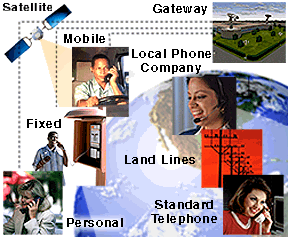 Several satellites pick up a call, and this "path diversity" assures that the call does not get dropped even if a phone moves out of sight of one of the satellites. As soon as a second satellite picks up the signal and is able to contact the same terrestrial "gateway", it begins to simultaneously transmit. If buildings or terrain block your phone signal, this "soft-handoff" prevents call interruption. The second satellite now maintains transmission of the original signal to the terrestrial "gateway". Additional advantages of using Low Earth Orbiting satellites within the Globalstar system include no perceptible voice delay and lighter / smaller all-in-one handsets. The satellites utilize a "bent-pipe" architecture. On any given call, several satellites transmit a caller's signal via CDMA technology to a satellite dish at the appropriate Gateway. Gateways process calls, then distribute them to existing fixed and cellular local networks. Terrestrial gateways are an important part of Globalstar's strategy to keep key technology and equipment easily accessible and to integrate our services as closely as possible with existing local telephony networks. This makes the Globalstar system and its services simple to manage, expand and improve.
Globalstar Satellites
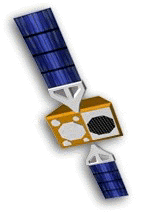 The Globalstar satellite is simple and proven. Each consists of an
antenna, a trapezoidal body, two solar arrays and a magnetometer.
The Globalstar satellite is simple and proven. Each consists of an
antenna, a trapezoidal body, two solar arrays and a magnetometer.General Characteristics: Total weight - 450kg, Number of Spot beams - 16 Power - 1100W Lifetime - 7.5 years Allocated frequencies:
Whether you're in need of a satellite-based mobile phone for travel or a fixed phone for remote but economical on-site communication, Globalstar offers world-class products and services, including high quality voice, roaming and Short Messaging Service (SMS), and later in the year 2000 positioning, asynchronous dial-up fax and data services up to 9,600 bps. Globalstar's mobile satellite phones, only slightly larger than traditional cellular phones, are built by three of the world's top wireless manufacturers, Ericsson, Qualcomm and Telit. These phones are multi-mode and work with terrestrial AMPS, CDMA, or GSM networks, as well as the Globalstar satellite network. Fixed phone options include models manufactured by Ericsson and Qualcomm, and public payphones, built by Schlumberger. A wide assortment of accessories is also available for increased freedom in the field, in your car or on your boat.
About Iridium System and Latest
News
 With the original service start on November 1,
1998, Iridium LLC (founded in 1991 and having invested about $7
billion) announced the end of commercial service on March 17,
2000. The service had been relaunched on March 28, 2001. The
concept for the Iridium system was proposed by Motorola engineers
Ray Leopold, Ken Peterson, and Bary Bertiger. They envision a
constellation of low orbiting satellites. Research and development
began in 1987.
With the original service start on November 1,
1998, Iridium LLC (founded in 1991 and having invested about $7
billion) announced the end of commercial service on March 17,
2000. The service had been relaunched on March 28, 2001. The
concept for the Iridium system was proposed by Motorola engineers
Ray Leopold, Ken Peterson, and Bary Bertiger. They envision a
constellation of low orbiting satellites. Research and development
began in 1987.The Iridium system was backed by 19 strategic investors from around the world: AIG Affiliated Companies, Iridium Africa Corporation, Iridium SudAmerica Corporation, Iridium Middle East Corporation, Khrunichev State Research and Production Space Center, Lockheed Martin Corporation, Iridium Canada, Inc., Iridium China (Hong Kong) Ltd., Iridium India Telecom Limited, Iridium Italia S.p.A., Raytheon Company, SK Telecom, South Pacific Iridium Holdings Limited, Sprint Iridium, Inc., Thai Satellite Telecommunications Co., Ltd., Motorola, Inc., Nippon Iridium (Bermuda) Limited, Vebacom Holdings, Inc., Pacific Asia Communications Ltd., Seventeen investor partners also participated in the operation and maintenance of 12 ground station "gateways" that link the Iridium satellite constellation to terrestrial wireless and landline public telephone networks. The 12 gateway operators also served as regional distributors of Iridium services in their designated commercial territories. Iridium operated constellation of 66 satellites in low earth orbit, at an altitude of 485 miles (780km).
Global Coverage
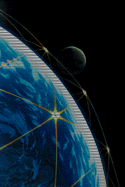 66 Iridium LEO satellites provide 100% Global Coverage. Although
there are four Countries which do not operate.These are Hungary,
Poland, N. Korea and N. Sri Lanka. Coverage Maps are divided into
two categories: Voice Maps and Paging Maps. Paging maps contain
Message Delivery Areas. (see Iridium
Pagers for more detailes)
66 Iridium LEO satellites provide 100% Global Coverage. Although
there are four Countries which do not operate.These are Hungary,
Poland, N. Korea and N. Sri Lanka. Coverage Maps are divided into
two categories: Voice Maps and Paging Maps. Paging maps contain
Message Delivery Areas. (see Iridium
Pagers for more detailes)
System
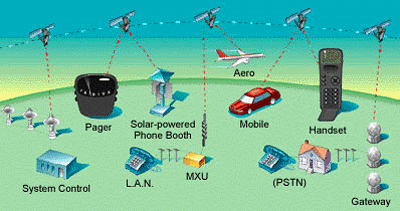 The IRIDIUM system is a satellite-based, wireless personal
communications network designed to permit any type of telephone
transmission - voice, paging, facsimile or data - to reach its
destination anywhere on Earth.
The IRIDIUM system is a satellite-based, wireless personal
communications network designed to permit any type of telephone
transmission - voice, paging, facsimile or data - to reach its
destination anywhere on Earth.It revolutionized communications for business professionals, travelers, residents of rural or undeveloped areas, disaster relief teams, and others who need the features and convenience of a wireless hand-held telephone with a single worldwide number. Unlike conventional telecommunications networks, the satellite-based system tracks the location of the telephone, providing global transmission even if the subscriber's location is unknown. In areas where compatible cellular service is available, the dual-mode telephone provides the option of transmitting a call via the local cellular system. IRIDIUM telephones provides high-quality voice connections and interface with laptop computers, personal digital assistants, palmtop organizers, and other communications equipment. The relatively short distance reduces the delay and enhances the quality of the telephone conversation. Each satellite covers an area 4,000 Km Wide. The phone call is transferred from cell to cell and from satellite to satellite as the spacecraft rise and set during their orbital motion (approximately one revolution around the earth per hour). The Gateways are continuously linked to at least two satellites of the constellation.
Iridium Satellites
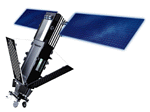 66 operational plus 6 in-orbit backup satellites are located in 6
orbital planes with the inclination of 86.4 degrees. Orbital
period 100 minutes, 28 seconds.
66 operational plus 6 in-orbit backup satellites are located in 6
orbital planes with the inclination of 86.4 degrees. Orbital
period 100 minutes, 28 seconds.General Characteristics: Satellite weight - 700 kg (1500 lb), Spot beams - 48 per satellite, link margin - 16 decibels (average), lifetime - 5-8 years. Allocated frequencies:
Iridium Phones & Pagers
With the Iridium system all communications services - Voice and Paging - are delivered regardless of the user location or the availability of traditional telecommunications networks. A variety of subscriber equipment is available to communicate with the Iridium network, including dual-mode handsets, specialized aeronautical and marine units, numeric and alphanumeric pagers. An Iridium Portable Telephone is quite similar to a conventional hand-held cellular terminal. Dimension, weight, battery lifetime were like terrestrial cellular phones. Still, it can operate in dual-mode, that is cellular mode or Iridium mode: the Iridium terminal is also a cellular terminal and could be used where cellular networks are available. An Iridium Pager offeres the first true "global roaming" capability in a small, belt-worn, personal message receiver.
About Inmarsat
 Established in 1979 to serve the maritime industry
by developing satellite communications for ship management and
distress and safety applications, Inmarsat currently operates a
global satellite system which is used by independent service
providers to offer an unparalleled range of voice and multimedia
communications for customers on the move or in remote locations.
While continuing to perform its original mandate, Inmarsat has
since expanded into land, mobile and aeronautical communications,
so that users now include thousands of people who live or work in
remote areas without reliable terrestrial networks, or travellers
anywhere. Users such as journalists and broadcasters, health teams
and disaster relief workers, land transport fleet operators,
airlines, airline passengers and air traffic controllers,
government workers, national emergency and civil defence agencies,
and heads of state.
Established in 1979 to serve the maritime industry
by developing satellite communications for ship management and
distress and safety applications, Inmarsat currently operates a
global satellite system which is used by independent service
providers to offer an unparalleled range of voice and multimedia
communications for customers on the move or in remote locations.
While continuing to perform its original mandate, Inmarsat has
since expanded into land, mobile and aeronautical communications,
so that users now include thousands of people who live or work in
remote areas without reliable terrestrial networks, or travellers
anywhere. Users such as journalists and broadcasters, health teams
and disaster relief workers, land transport fleet operators,
airlines, airline passengers and air traffic controllers,
government workers, national emergency and civil defence agencies,
and heads of state.The Inmarsat satellites are located in geostationary orbit 22,223 miles (35,786 km) out in space.
Global Coverage
 Inmarsat covers about 98% of the land mass area.
Inmarsat covers about 98% of the land mass area.Download map from here: Inmarsat Coverage Map (43.0Kb) Inmarsat Coverage Map (380.0Kb)
Regional Coverage (R-BGAN Only)
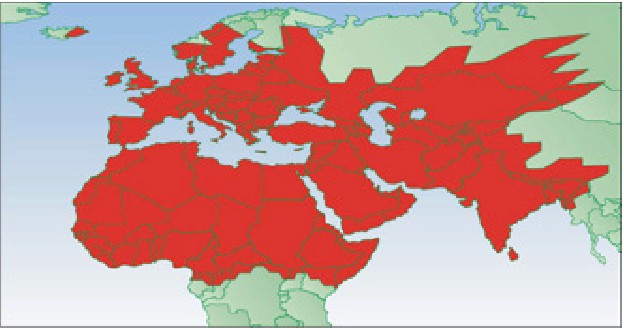 R-BGAN provides coverage in 99 countries.
R-BGAN provides coverage in 99 countries.Download map from here: Inmarsat Coverage Map (855.0Kb)
System
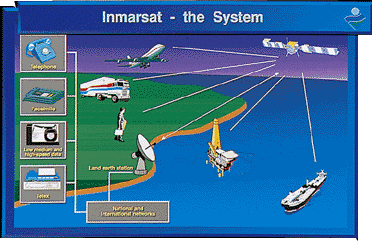 Each satellite covers up to one third of the Earth's surface and
is strategically positioned above one of the four ocean regions to
form a continuous 'world-wide web in the sky'. Every time a call
is made from an Inmarsat mobile satphone it is beamed up to one of
the satellites. On the ground, distributed all around the world,
giant communications antennas are listening for the return signal,
which they then route into the ordinary telephone network. And
when someone calls an Inmarsat customer, it happens the same way -
but in reverse.
Each satellite covers up to one third of the Earth's surface and
is strategically positioned above one of the four ocean regions to
form a continuous 'world-wide web in the sky'. Every time a call
is made from an Inmarsat mobile satphone it is beamed up to one of
the satellites. On the ground, distributed all around the world,
giant communications antennas are listening for the return signal,
which they then route into the ordinary telephone network. And
when someone calls an Inmarsat customer, it happens the same way -
but in reverse.
Inmarsat Standards
According to different use and purposes Inmarsat System is divided in several standards. Inmarsat mini-M. Inmarsat's most popular service, designed to exploit the spotbeam power of the Inmarsat-3 satellites, the latest Inmarsat mini-M phones are the smallest, lightest and cheapest ever made. Weighing about 2kg and the size of a notebook computer, prices range from $3,000 for the phoe and $2.5 a minute airtime. Maritime, land, vehicular and semi-fixed versions are available. Inmarsat-GAN. Introduced in the end of 1999, provides Global Area Network(GAN) services, including speech at 4.8 Kbps, fax and high speed data (up to 64 Kbps), ISDN, IPDS(Inmarsat Packet Data Service), Internet access, E-mail access, video conferencing. Inmarsat R-BGAN. Introduced on November 18, 2002, provides superfast links to the Internet, corporate intranets and key business applications, such as e-mail, web browsing, file transfer, Virtual Private Networks and e-commerce. Inmarsat-A. The original service introduced in 1982, providing direct-dial telephone, fax, data, telex and e-mail. Inmarsat-B. Introduced in 1993, this is a digital successor to Inmarsat-A. It offers servicec similar to those of Inmarsat-A, but with sugnificant reduction in call cost due to its more efficient use of radio frequencies. Inmarsat-C. A two-way, packet data service via lightweight, low-cost terminals, small enough to be hand-carried or fitted to any vessel, vehicle or aircraft. Approved for use under the Global Maritime Distress and Safety System (GMDSS), and ideal for distributing and collecting information from fleets of commercial vessels or vehicles. Inmarsat-D+. Offers global two-way data communications using terminals no bigger than a personal CD player. Complete with integrated GPS, D+ system are ideally suited for tracking, short data messaging, and supervisory control and data aquisition. (SCADA) applications. Inmarsat-E. Provides global maritime distress alerting services transmitted from emergency position indicating radio beacons (epirbs) and relayed through Inmarsat coast earth stations. Covers vertually all of the world's ocean areas and is fully compliant with the Global Maritime Distress and Safety System (GMDSS). Inmarsat-M. The world's first personal, portable mobile satellite phone introduced in 1993, making possible telephone, Group 3 fax and data calls from a briefcase-sized terminal. Also available in maritime versions with radome antennas as small as 70cm in diameter. Aero-C. A low-cost messaging and data reporting service providing aircraft with store-and-forward satcoms. Ideal for aircraft flying in regions where radio communication is difficult or impossible. In addition to its proven position repoting facility, Aero-C can be used for weather and flight plan updates, maintenance and fuel requests, and business and personal communications. Aero-H. Introduced in 1990, offering telephone, fax and data communications in aircraft passenger cabins and cockpits. It is also used for airline operations and air traffic control. Aero-I. An intermediate-gain telephone, fax and data services for short and medium-haul aircraft that operates within Inmarsat-3 spotbeams and makes possible a new generation of smaller, lighter and cheaper avionics and antennas. Aero-L. A low-gain aeronautical satcom service offering real-time, two-way air to ground data exchange at 600bps. Complies with International Civil Aviation Organization(ICAO) requirements for safety and air traffic control. Aero mini-M. Designed for small corporate aircraft and general aviation users, for voice, fax and 2,4Kbps data. Externally mounted antenna links to a small terminal weighing about 4.5 kg. Particulary useful in areas beyond the reach of VHF radio.
Series-2 Satellites
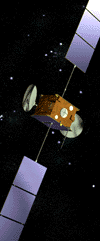 The four Inmarsat-2 satellites were built by an international
consortium headed by the Space & Communications division of
British Aerospace (now part of the Anglo-French company Matra
Marconi Space). Subcontractors included Hughes Aircraft Company
(US), Fokker (The Netherlands), Matra (France), MBB (Germany),NEC
(Japan), and Spar (Canada). Satellite ground control operations
contractors included CLTC (China), CNES (France), SED (Canada),
Telespazio (Italy), and Intelsat.Inmarsat-2 is a
three-axis-stabilized satellite design based on the Eurostar
satellite platform, developed by British Aerospace and Matra
Espace (both now part of Matra Marconi Space). The satellites were
designed for a 10-year life. At launch, each weighed 1,300 kg, had
an initial in-orbit mass of 800 kg and 1,200 watts of available
power. The communications payload has two transponders, providing
outbound (C- to L-band) and inbound (L- to C-band) links with
mobile terminals in the 6.4/1.5 and 1.6/3.6 GHz bands. The
effective L-band isotropic radiated power (EIRP) is 39 dBW. Each
satellite's global beam covers roughly one-third of the Earth's
surface. Depending on demand, bandwidth and EIRP can be
dynamically allocated for communications for maritime,
aeronautical and land mobile applications.
The four Inmarsat-2 satellites were built by an international
consortium headed by the Space & Communications division of
British Aerospace (now part of the Anglo-French company Matra
Marconi Space). Subcontractors included Hughes Aircraft Company
(US), Fokker (The Netherlands), Matra (France), MBB (Germany),NEC
(Japan), and Spar (Canada). Satellite ground control operations
contractors included CLTC (China), CNES (France), SED (Canada),
Telespazio (Italy), and Intelsat.Inmarsat-2 is a
three-axis-stabilized satellite design based on the Eurostar
satellite platform, developed by British Aerospace and Matra
Espace (both now part of Matra Marconi Space). The satellites were
designed for a 10-year life. At launch, each weighed 1,300 kg, had
an initial in-orbit mass of 800 kg and 1,200 watts of available
power. The communications payload has two transponders, providing
outbound (C- to L-band) and inbound (L- to C-band) links with
mobile terminals in the 6.4/1.5 and 1.6/3.6 GHz bands. The
effective L-band isotropic radiated power (EIRP) is 39 dBW. Each
satellite's global beam covers roughly one-third of the Earth's
surface. Depending on demand, bandwidth and EIRP can be
dynamically allocated for communications for maritime,
aeronautical and land mobile applications.Spacecraft 2F1 Located POR 179 deg East Back-up spacecraft for Inm3-F3 Launched October 30, 1990 by Delta rocket Originally in service (IOR) December 8, 1990 Spacecraft 2F2 Located AOR-West 98 deg west Carries leased services and also a back-up spacecraft for Inm3-F4 Launched March 5, 1991 by Delta rocket Originally in service (AOR-E) April 13, 1991 Spacecraft 2F3 Located IOR 65 deg East since March 4, 1997 Back-up spacecraft for Inm3-F1 Launched December 16, 1991 by Ariane rocket Originally in service (POR) January 19,1992 Spacecraft 2F4 Located AOR-West 109 deg East Carries leased services Launched April 15, 1992 by Ariane rocket In service May 31, 1992
Series-3 Satellites
US-based Lockheed Martin Astro Space built the spacecraft bus, the structure and systems that serve as the satellites basic utilities, based on the Astro Space Series 4000.UK-based Matra Marconi Space built the communications payload which included antennas, repeater and other communications electronics.The communications payload operates in the C- and L-band portions of the radio spectrum. Each satellite has its antennas and electronics tuned for optimum coverage of a particular area on Earth, known as its footprint.The tremendous advantage of the Inmarsat-3 satellites is their ability to concentrate power on particular areas of high traffic within the footprint. Each satellite utilises a maximum of seven spot beams and one global beam. The number of spot beams will be chosen according to traffic demands. In addition, these satellites can re-use portions of the L-band frequency for non-adjacent spot beams, effectively doubling the capacity of the satellite. Each satellite weighs about 2,066 kg at launch, compared to 1,300 kg for an Inmarsat-2 satellite. The satellites produce up to 48 dBW of EIRP - the effective isotropic radiated power, a measure of how much signal strength a satellite can concentrate on its service area. Spacecraft 3F1 Launched April 3, 1996 on Atlas Centaur IIA Lift off from Cape Canaveral On-station location 64.0 degs east (IOR) In-service date 11th May 1996 Spacecraft 3F2 Launched September 6, 1996 on Proton D-1-E Lift off from Baikunur On-station 15.5 degs west (AOR-E) In service date 06:00 13th October 1996 Spacecraft 3F3 Launched December 18, 1996 on Atlas Centaur IIA Lift off from Cape Canaveral On-station location 178 degs east (POR) In service date 17:50 25th January 1997 Spacecraft 3F4 Launched June 3, 1997 on Ariane 4 Lift off from Kourou, French Guiana On-station location 54 degs west (AOR-W) In service date 26th July 1997 Spacecraft 3F5 Launched February 3, 1998 on Ariane 4 Lift off from Kourou, French Guiana On-station location 25 degs east Carries leased services and also a back-up spacecraft for Inm3-F2
Series-4 Satellites
Three Inmarsat I-4 satellites to be lauched in 2004 and are currently under development of Astrium (previously Matra Marconi Space). New satellites will be 100 times more powerfull to provide speeds up to 432Êbps. Advanced technology will allow to reduce service cost by around 75% compared to existing Inmarsat-M4 charges. New service will be identified as B-GAN - Broadband Global Area Network.
About Thuraya
 Established in April 1997 in the UAE as a private joint stock company, Thuraya has a shareholder base made up of 18 prominent telecommunications operators and investment houses. As of today Thuraya has more then 100 000 subscribers. Thuraya offers following Telecommunications Services:
Current Regional Coverage
 Thuraya provides coverage in 99 countries of the world:
Afghanistan, Albania, Algeria, Andorra, Armenia, Austria,
Azerbaijan, Bahrain, Bangladesh, Belarus, Belgium, Benin,
Bhutan, Bosnia Herzegovina , Bulgaria, Burkina Faso, Cameroon,
Central African Republic, Chad, Croatia, Cyprus, Czech Republic,
Denmark, Djibouti, Egypt, Eritrea, Estonia, Ethiopia, FR of
Yugoslavia, France, Gambia, Georgia, Germany, Ghana, Gibraltar,
Greece, Guernsey, Guinea, Guinea Bissau, Hungary, India, Iran,
Iraq, Ireland, Isle of Man, Italy, Ivory Coast, Jersey, Jordan,
Kazakhstan, Kuwait, Kyrghyzstan, Latvia, Lebanon, Liberia,
Libya, Liechtenstein, Lithuania, Luxembourg, Macedonia, Mali,
Malta, Mauritania, Moldova, Monaco, Morocco, Nepal, Netherlands,
Niger, Nigeria, Oman , Pakistan, Palestine, Poland, Portugal,
Qatar, Romania, Russia, Saudi Arabia, Senegal, Sierra Leone,
Slovakia, Slovenia, Somalia, Spain, Sri Lanka, Sudan,
Switzerland, Syria, Tajikistan, Togo, Tunisia, Turkey,
Turkmenistan, Ukraine, United Arab Emirates, United Kingdom,
Uzbekistan, Yemen.
Thuraya provides coverage in 99 countries of the world:
Afghanistan, Albania, Algeria, Andorra, Armenia, Austria,
Azerbaijan, Bahrain, Bangladesh, Belarus, Belgium, Benin,
Bhutan, Bosnia Herzegovina , Bulgaria, Burkina Faso, Cameroon,
Central African Republic, Chad, Croatia, Cyprus, Czech Republic,
Denmark, Djibouti, Egypt, Eritrea, Estonia, Ethiopia, FR of
Yugoslavia, France, Gambia, Georgia, Germany, Ghana, Gibraltar,
Greece, Guernsey, Guinea, Guinea Bissau, Hungary, India, Iran,
Iraq, Ireland, Isle of Man, Italy, Ivory Coast, Jersey, Jordan,
Kazakhstan, Kuwait, Kyrghyzstan, Latvia, Lebanon, Liberia,
Libya, Liechtenstein, Lithuania, Luxembourg, Macedonia, Mali,
Malta, Mauritania, Moldova, Monaco, Morocco, Nepal, Netherlands,
Niger, Nigeria, Oman , Pakistan, Palestine, Poland, Portugal,
Qatar, Romania, Russia, Saudi Arabia, Senegal, Sierra Leone,
Slovakia, Slovenia, Somalia, Spain, Sri Lanka, Sudan,
Switzerland, Syria, Tajikistan, Togo, Tunisia, Turkey,
Turkmenistan, Ukraine, United Arab Emirates, United Kingdom,
Uzbekistan, Yemen.
System
Thuraya’s Mobile Satellite System comprises three key segments:
Thuraya Satellites
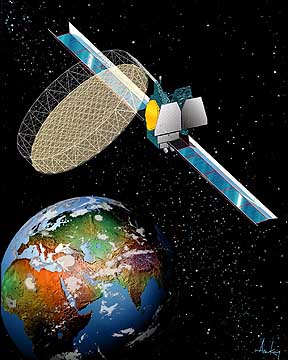 Two Thuraya Satellites were and third one is being built by
Boeing Satellite Systems. The satellites are designed for a
12-15 year life. The satellite is equipped with an innovative
40-foot (12.25-meter) L-band transmit-receive reflector
provided by TRW Astro Aerospace. The large reflector is
combined with Boeing’s on-board digital signal processing to
create an active phased-array antenna that allows the
spacecraft to create more than 200 spot beams and handle
13,750 simultaneous phone calls. The digital signal processor,
five times more capable than any previous Boeing digital
processor, has more computing power than 3,000 Pentium
III-based computers.
Two Thuraya Satellites were and third one is being built by
Boeing Satellite Systems. The satellites are designed for a
12-15 year life. The satellite is equipped with an innovative
40-foot (12.25-meter) L-band transmit-receive reflector
provided by TRW Astro Aerospace. The large reflector is
combined with Boeing’s on-board digital signal processing to
create an active phased-array antenna that allows the
spacecraft to create more than 200 spot beams and handle
13,750 simultaneous phone calls. The digital signal processor,
five times more capable than any previous Boeing digital
processor, has more computing power than 3,000 Pentium
III-based computers.Payload Subsystem:
- FDMA carrier channel BW 27.7 kHz - Channel bit rate is 46.8kbps
Solar - Beginning of life 13KW - End of life 11KW - Panels are 2 wings of 4 panels each w/dual-junction gallium arsenide cells Batteries -250 A-hr cells Dimensions In orbit - L, solar arrays 34.5 m (113ft) - W,antenna 17m (55.7 ft) Stowed -H:7.6m (25 ft) -W:3.75m * 3.75m (12.3 ft) Weights - 5250 kg (11,576 lb) Launch - 3200 kg (7,056 lb) In orbit (beginning of life) Allocated Frequencies:
Satellite Location: Located 44 deg East Launched October 21, 2000 on board a Sea Launch Zenit-3SL rocket from the equator in the middle of the Pacific Ocean by Delta rocket To be located 28.5 deg East To be launched in January 2003 To be located 87 deg East Launch date is not determined
Thuraya Equipment
Thuraya handsets are very compact and look almost like GSM phone. See Video Clip (10.0 Mb) about using Thuraya phone. Thuraya's handsets are being manufactured by 2 major suppliers: Hughes and Ascom.
No matter where you are - Thuraya gives coverage: On open sea, in the middle of a desert - outside of GSM coverage; Thuraya is there! List
of available Thuraya accessories
How Iridium WorksIridium essentially is a satellite-based cell-phone system. Similar to a ground-based Global System for Mobile communications (GSM) cell-phone network, Iridium's satellites function as orbiting cell site base stations. Each Iridium phone is fitted with a Subscriber Identity Module (SIM) card, similar to a cell phone. The SIM card provides a digital signature used for authentication, registration and location of the user, similar to its function in a cell phone. As soon as an Iridium phone is switched on, it makes contact with the nearest satellites, using 1616.0 to 1626.5 MHz L-band links, and goes through the user authentication process. Once that's complete, the Iridium phone is ready to use. The satellite cell sites, instead of being linked to each other and to a master control center by means of land telephone lines, use three Ka-band communications links, one for inter-satellite communications, a second for down-linking to the ground-earth station and a third for up-linking to the GES. Calls are cross-linked from one satellite to the next until they reach the satellite that's nearest to Iridium's primary ground-earth station gateway in Tempe, Ariz. Calls then are connected from the nearby satellite to the Tempe gateway, which in turn routes them to other types of phone systems, including land-based telephones and INMARSAT satcom phones. For redundancy, there's also a secondary ground-earth gateway station at Fucino, Italy. The Department of Defense has its own gateway station in Hawaii. The satellites move by at almost 13,000 nm/hour, so they're designed with enough computing power to hand off the Iridium phone user to the next satellite in the same orbit plane. Hand-offs occur about every 17 minutes, if the user is stationary. Hand-off times vary if the user is in motion. Each satellite has enough power to handle 1,100 callers simultaneously. Total system capacity is 72,600 callers at any one time. Industry observers believe this is enough capacity to serve one to three million subscribers. System capacity can be boosted by adding more satellites to each of the six orbits. And currently, there are 14 in-orbit spares that can be activated, plus two more satellites awaiting final assembly and launch on the ground. Incoming calls to Iridium phone users from other telephone networks can be placed by using international calling procedures. Iridium's international calling code is 881 6, similar to the 881 country code used for access to other satcom phone systems. But it's nearly as expensive as other systems. Iridium negotiated a special deal with AT&T, for example, enabling landline phone users to call an Iridium phone for $1.99 per minute. Calling other types of satcom phones may cost up to $9 per minute. Some service plan
providers now offer two-stage dialing for landline callers. This
feature enables the caller to dial a telephone number with a U.S.
area code. Once connected, the caller hears a second dial tone,
enabling the Iridium phone to be called directly, and billing starts
at $1.49 per minute either to the Iridium phone user or landline
caller, depending upon the service plan.
Iridium
is the first and only truly global paging service. Whether it is
sold as a stand-alone service or in conjunction with Iridium voice
services, a subscriber may receive paging messages virtually
anywhere on earth, from remote areas like the ocean or poles to
populated metropolitan areas. Currently
users may receive up to 150 pages per month. A maximum of five
messages can be sent by the Web site or e-mail, every 10 minutes to
a single Iridium paging subscriber. Enter
the Iridium customer's Iridium pager or phone number (starting with
8816). Your
message will reach Iridium customers virtually anywhere on or above
the surface of the earth. Your
message will be routed through the Iridium network, which combines
the global reach of 66 low-earth-orbit satellites to cover every
location on the planet. Because Iridium is a satellite service,
placing your pager or phone in clear line of sight to the satellites
will improve message delivery. The
user can push a button on the top of the pager. The pager will
display the current satellite signal strength. Delivery
time for Iridium pager messages depends on the length of the
message, and the routing time to the pager. Most messages will be
delivered within 7 minutes. Almost all pager messages will be
delivered within 15 minutes. E-mails
can be sent to Iridium pagers or phones by entering the Iridium
phone or pager number into the following generic address,
8816[number]@msg.iridium.com. You
may send a maximum of 160 characters. Any messages in excess of 160
characters will be truncated. Iridium Frequently Asked QuestionsCan I use a Solar Charger to charge both my Iridium phone and my laptop computer at the same time? No. The solar charger is designed specifically to charge the Iridium phones.
How can I display
my SIM card phone number?
Step 1 - Press Menu until you see "Phone Book", and then press "OK" to select. Step 2 - Press Menu untill you see "My Phone Number(s)", and then press "OK" to select. Step 3 - Your SIM card phone number will be displayed. Step 4 - Press and hold "C" to exit the menu. Note: If you do not see your number(s), they have not been programmed onto your SIM card. Contact your Service Provider for more information.
How do I make
calls to/from the Iridium system?
Example 1 – Originating a call from a landline phone in the United States terminating to an Iridium satellite phone. It does not matter where the satellite phone is located, the dialing is the same. From the landline phone, dial: 011 8816 XXX XXXXX 011, International Direct Dial (IDD) access code for United States/8816 XXX XXXXX, the MSISDN Example 2 – Originating a call from a landline phone outside of the United States terminating to an Iridium satellite phone. It does not matter where the ISU is located, the dialing pattern is the same. From the landline phone, (i.e. France) dial: 00 8816 XXX XXXXX 00, International Direct Dial (IDD) access code for France / 8816 XXX XXXXX, the MSISDN. Example 3 – Originating a call from the Iridium satellite phone (does not matter where the satellite phone is located) to a landline phone located in the United States. From the satellite phone, dial: 00 1 602-752-XXXX 00, for all outbound calls from the satellite phone/ 1, United States country code/ 602, area code/752-XXXX, actual phone number. Example 4 – Originating a call from an Iridium satellite phone (does not matter where the satellite phone is located) to a landline phone located in another country. From the satellite phone, dial: 00 CC XXXXXX 00, for all outbound calls from satellite phone/CC, country code/XXXXXX, actual number. Example 5 – Originating a call from an Iridium satellite phone (does not matter where the satellite phone is located) to another Iridium satellite phone. From the satellite phone, dial: 00 8816 XXX XXXXX
How do I register
my 9500/9505 phone with the satellite network?
Step 1 - Press the "up arrow" then 8 on the phone. Step 2 - The phone screen will display "Registering". Step 3 - When you see "Registered" and the signal strength indicator or the home signal on the phone screen you are ready to make a call. Step 4 - If you see "Rotate Antenna" extend antenna upward and make sure you have a clear view of the sky. Step 5 - If you see "Call Failed", "System Busy", "Restricted Area", or "Weak Signal", this means the phone is unable to access the network. Try again in a few minutes.
How do I use the
quick access keys on the Motorola 9500?
Up Arrow and 1 –
Find phone book entry by name.
Up Arrow and 2 – Check signal strength. Up Arrow and 3 – Call voicemail. Up Arrow and 4 – Show battery meter. Up Arrow and 5 – Lock phone now. Up Arrow and 6 – Turn vibrate alert on and off. Up Arrow and 7 – Read messages. Up Arrow and 8 – Register with the satellite network now. Up Arrow and 9 – Turn forwarding all calls on and off.
What are the
differences between the 9505 and the 9505A?
The 9505A will continue to have the same features and functions as the 9505. Also, the 9505A has a similar form and, therefore, has virtually the same look and feel as the 9505. Two differences include:
Changes to certain accessories were also required to accommodate component changes internal to the phone. These include:
What do the
display messages on my phone mean?
Power On Messages Blocked - If the SIM card PIN code is incorrectly entered three times in a row, your phone becomes blocked. Please contact your Service Provider. Blocked, Contact Your Supplier - Please contact your Service Provider immediately. Check Card - This message indicates that the SIM card is damaged or inserted incorrectly. Enter Phone Unlock Code - Your phone was locked after the last use. Enter your four-digit unlock code and press "OK". Enter PIN - Enter the 4-8 digit SIM card PIN. If you are unsure what the PIN is, contact your Service Provider. Enter PUK - Please contact your Service Provider. Insert Card - Power off your phone; make sure your SIM card is inserted completely; and then power your phone on again. Registering - Your phone is registering with the network. When the process is complete, you will see "Registered". Rotate Antenna or Orient Antenna - You also hear a tone when you see these messages. Extend the antenna upward and make sure you have a clear line of sight. Searching… - The phone is attempting to establish connection to the satellite.
What do the
service light indicators mean?
Alternating Red and Green: An incoming call. Flashing Green: You are receiving a signal from the satellite, and can place and receive calls. Flashing Yellow and Red: You did not successfully register with the satellite and cannot receive any incoming calls. Your SIM card may be inserted incorrectly, may not be inserted, or you may be in a restricted area. (See message on phone) Flashing Red: Service is not available.
What is the
function of the SIM card?
SIM (Subscriber Identity Module) cards are currently used in all GSM-based systems. The SIM card is a removable module that contains user identity, account information, and stores phone numbers which can be used in any compatible phone where your SIM card is present. When inserted into a telephone, it allows you to place or receive calls. The SIM card may already be inserted into your phone when you receive it from the dealer. If it is not, you can easily insert it into the slot provided on the handset.
|
|
||||||||||||||||||||||||||||||||||||||||||||||||||||||||||||||||||||||||||||||||||||
| ©2002-2005 HighSpeedSat | ||||||||||||||||||||||||||||||||||||||||||||||||||||||||||||||||||||||||||||||||||||||